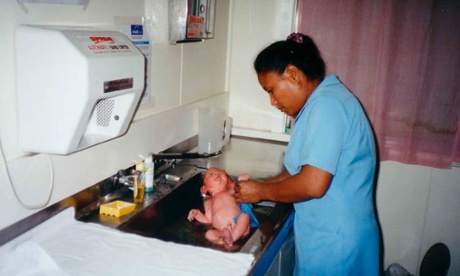Children in Australia’s immigration detention sign their artworks with ID numbers. They emulate Serco guards when they play. They are traumatised and are losing hope

Australia’s system of mandatory detention can only be described as child abuse. It’s at odds with many of our own domestic provisions and is totally at odds with the UN Convention on the Rights of the Child. This year marks the 25th anniversary of the convention, which Australia was among the first to ratify. For around 20 of those years we have stripped a whole group of children of their basic rights.
The immigration detention model we have today knowingly damages people, but then attempts to apply costly, inefficient bandaids that never stick. $85,000 for one medevac flight off Nauru, for a pregnant woman who should never have been there in the first place; a teenage boy having three appointments every week with mental health specialists and living on a cocktail of prescription drugs all to cope with the system he is trapped in – this is obscene.
Children are signing their artworks with ID numbers. I have met parents so institutionalised and used to being referred to by number that they are distressed by the fact their baby has no ID number. The baby is born in an Australian hospital but the parents are not given a birth certificate. Some have tried to hold onto the hand or foot ID tag issued by the hospital, not just as a keepsake, but as something formal, tangible, to prove their baby exists. The tag ends up locked in the property section of the detention facility.
Attempts are being made to provide education on Christmas Island, an improvement from the current appalling situation, but not a solution. It is not appropriate to try and educate a child inside a facility that causes trauma and mental health harm. This presents issues of inequity when we are looking at remote locations such as Nauru and to some degree, Christmas Island – just another reason why these locations should not be used long-term for immigration purposes.

The average time spent in detention is 324 days. Teachers are telling us that things are changing. Students who were once engaged and keen to learn have lost interest and are displaying concerning behaviours. This is put this down to the longevity of detention. Children, particularly the older ones. have realised there is no hope – what’s the point in learning if they’re going to be locked up forever or sent to Nauru?
Serco have repeatedly spoken to me about “parent-led decision making” and the like. Such statements are completely at odds with what is right in front of these staff every day. If a child needs something, it is someone in uniform who provides it. What will my child eat? When will they eat? Who will they play with? What will they wear? What cake will I make for their birthday? What job will I have to support my family? The family unit struggles immensely to answer these questions in the detention environment.

Some may argue that the right to play exists regardless of location and that all children will find a way to play. Does it count if a five year old girl is playing “officers”, an emblem drawn on her shoulder in pen, bossing other children around using ID numbers? Is it play when the ground is sharp coral, when the playground equipment is too hot to use, when the toy room is 6m x 2.4m and only open a few hours a day? Is it play when your parents are so traumatised they cannot even sit and do a puzzle with you? Is it play when you have to explain to your Australian school friends that you cannot come to their birthday party on the weekend because the guards won’t let you?
Overall, there is no such thing as a child-friendly detention facility. That said, there are many improvements that could be made to physical infrastructure and operational detail that would mitigate some harm caused to children and would see asylum seekers treated with more dignity and humanity.
While the department of immigration and border protection includes some terrific individuals it is not a child protection or child specialist agency. No immigration minister can be a fit guardian to act in the best interests of an unaccompanied child seeking protection.
These are issues of child rights and should be seen as such. If we do not create change in this system a child will die because of it.
This is an edited version of Sophie Peer’s statement to the Senate Inquiry into Manus Island.
